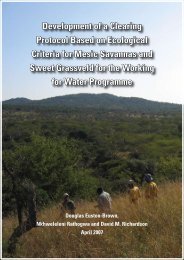Metsi Consultants - DWA Home Page
Metsi Consultants - DWA Home Page
Metsi Consultants - DWA Home Page
You also want an ePaper? Increase the reach of your titles
YUMPU automatically turns print PDFs into web optimized ePapers that Google loves.
Report No 678-F-001<br />
METSI CONSULTANTS: SUMMARY OF MAIN FINDINGS FOR PHASE 1 DEVELOPMENT<br />
floods, would pass through the weir gate. Matsoku dry-season low flows would not be reduced as much as in the<br />
other rivers because of the 0.6 m 3 s -1 constant environmental release, however, the river would be affected by a<br />
loss of variability in the flow regime.<br />
6.2. BIOPHYSICAL CONSEQUENCES<br />
The impacts of the Treaty flow regimes on the rivers would be the most severe of the scenarios and manifested<br />
as strongly deteriorating physical and chemical conditions (relative to natural), particularly in the reaches<br />
immediately downstream of the dams. Almost all aspects of geomorphology and water quality at three of the eight<br />
IFR Reaches (2, 3 and 7). are predicted to show severe and/or critically severe changes. Because of<br />
unregulated, incremental inflow from the surrounding catchments, the lower Senqu River (Reaches 5 and 6) is<br />
expected to be the least affected, with low to moderate effects expected in the Senqu River at Reach 4, and the<br />
Senqunyane River at Reach 8.<br />
As a result of changing the constant releases through Matsoku Weir from 0.05 to 0.6 m 3 s -1 the severity of<br />
biophysical impacts in Reach 1 are much reduced from that assessed earlier (LHDA 648-F-02).<br />
Geomorphological impacts are judged to be reduced from critically severe to severe, water quality and<br />
macroinvertebrates from critically severe to moderate, vegetation from severe to moderate, and amphibia,<br />
mammals and birds from severe to low. The presence of the weir itself remains a major impact on fish<br />
populations, including the highly endangered Maluti minnow.<br />
Immediately downstream of the Katse and Mohale Dams, critically severe changes are predicted in most physical<br />
and chemical aspects. Significant reductions in pool numbers, depths and sizes, are anticipated, with pools<br />
disappearing almost completely in the higher reaches. The transport of sand, and shifting, scouring and sorting of<br />
larger bed elements is expected to virtually cease, except during very rare large floods. The anticipated<br />
consequences of this are that river beds would increasingly silt up; with all but the few remaining areas with<br />
slightly faster flow gradually acquiring a relatively featureless, muddy bottom. Riffles would be largely or<br />
completely lost in many reaches, and deep, soft deposits of mud would line river margins and fill backwaters.<br />
There would be little of the habitat diversity and clean, scoured rock surfaces necessary for a diverse, healthy<br />
aquatic community. Conditions would improve somewhat after large floods, but increasingly larger floods would<br />
be necessary to reverse the deterioration as these changes became entrenched.<br />
The reductions in low flows are expected to lead to corresponding reductions in temperature buffering capacity,<br />
and to result in greater extremes of day and night temperatures. This would be followed by widespread<br />
distribution of dense algal growths, particularly in IFR Reach 2. Daily ranges of water temperatures would<br />
increase, as the small volumes of cold water released from the dams warmed up during the day but less so at<br />
night. This effect could be mitigated in the Senqunyane River by mixing releases from different levels in Mohale<br />
Dam wall to match as closely as possible the desired water temperature regime in the downstream river reaches.<br />
In Reaches 2, 3 and 7, wetbank vegetation is expected to show moderate (20-40%) to severe (40-80%) changes<br />
and the drybank vegetation severe to critically-severe changes, with an increased potential for encroachment of<br />
exotic woody vegetation (such as Acacia dealbata).<br />
Predicted shifts in invertebrate abundance would be mainly of concern in Reaches 2 and 7, and to a slightly<br />
lesser extent in Reach 3. Here the shifts are expected to be in the moderate (20-40%) to severe (40-80%)<br />
categories. There are as many increases in abundance predicted as decreases, and the overall abundance of<br />
organisms would theoretically remain the same. However, many replacement species would live in muddy<br />
32

















